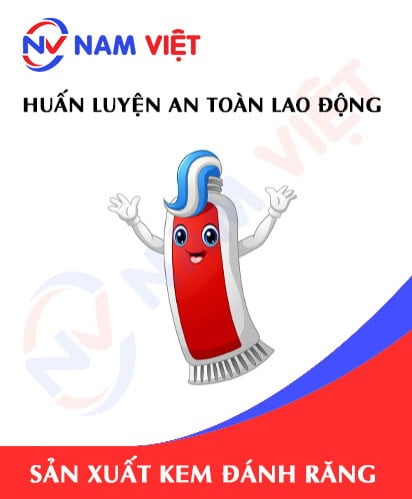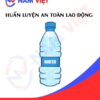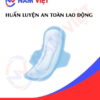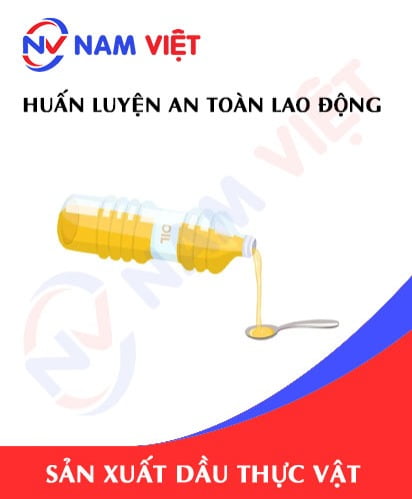Occupational safety training for toothpaste manufacturing
99,000 ₫
Note: The above price is calculated per person, the price may vary depending on the number of trainees participating in the course and market fluctuations. For more accurate price support, please refer to the quotation or contact our consultants directly.
Occupational safety is an important issue in factories manufacturing toothpaste and needs to be addressed promptly to ensure the health and safety of workers, enhancing the reputation of businesses. The Occupational Safety Training course is one of the effective solutions to raise awareness about how to prevent workplace accidents for workers involved in toothpaste manufacturing.
Table of Contents
Toggle1. Overview of toothpaste
a. What is toothpaste?
- Toothpaste is an oral care product used to clean teeth, whiten teeth, remove plaque, and prevent tooth decay. Toothpaste is usually packaged in plastic tubes and is often white, flavored, and contains fluoride and other ingredients like peppermint oil, menthol, baking soda, sodium lauryl sulfate, and enzymes to help whiten teeth and remove plaque. Toothpaste is a product used daily by millions of people worldwide to maintain oral health.
- Many famous toothpaste brands from foreign corporations have been imported into Vietnam, and there are also many Vietnamese enterprises that manufacture and distribute toothpaste domestically.
- Toothpaste manufacturing companies in Vietnam are developing on a small to large scale, from small manufacturing facilities with simple technology to large companies with modern manufacturing technology. Many businesses also invest in research and development of new toothpaste products to meet the increasing demands of the market.

b. Types of machinery for toothpaste manufacturing
The types of machinery for toothpaste manufacturing include:
- Ingredient mixer: a machine used to mix the basic components of toothpaste, including caustic soda, calcium carbonate, silica gel, glycerin, water, flavoring, and other additives.
- Cream filling machine: a machine used to press and package toothpaste into tubes or boxes.
- Packaging machine: a machine used to package the toothpaste product, including steps such as printing, labeling, and packaging the product into boxes or bags.
- Quality control machine: a machine used to inspect the quality of the toothpaste product, ensuring that it meets standards for safety, effectiveness, and flavor.
- Tube softening machine: a machine used to soften plastic tubes so that the toothpaste product is easy to package and use.
In addition, businesses also use other equipment such as dryers, shapers, rollers, chemical mixers, and other equipment for the manufacturing and packaging process.

c. Typical toothpaste manufacturing enterprises
In Vietnam, there are many typical toothpaste manufacturing enterprises such as:
- Unilever Vietnam: a multinational company, headquartered in the UK, operating in the field of manufacturing and trading health, beauty, and household products. Clear and Signal toothpastes are two famous products of Unilever Vietnam.
- P/S Vietnam: a toothpaste brand belonging to the Pepsico group, headquartered in the US. P/S toothpaste is famous for its “Micro Shine Crystal” technology, which helps protect teeth from tooth decay and protects tooth enamel.
- Colgate-Palmolive Vietnam: a company that manufactures and trades oral and body care products. Colgate toothpaste is a world-renowned brand with a variety of products such as Colgate Total, Colgate Max Fresh, Colgate Sensitive, and Colgate Junior.
- Oriental Pharma: a company that manufactures and distributes healthcare products, including Opharm toothpaste. This product is produced with a special formula that helps protect oral health, treat oral diseases, and provide fresh breath.
- Traphaco Joint Stock Company: a company that manufactures and distributes healthcare products, including Dr. Thanh toothpaste. This product is made from natural ingredients, helps protect oral health, and has an effect on treating oral-related diseases.
d. Specific jobs in a toothpaste manufacturing factory
Group 1
- Executive director, deputy executive director, department manager in a toothpaste manufacturing factory.
Group 2
- Safety officer: manages safety in the factory, designs safety procedures, supervises and urges employees to comply with safe work procedures.
Group 3
- Ingredient manufacturing: Ingredients such as flavorings, foaming agents, plasticizers, antibacterial agents, and surfactants are manufactured and packaged into complete units.
- Mixing: The ingredients are mixed together to form the toothpaste mixture.
- Packaging: The toothpaste is packaged in tubes or bottles with labels, manufacturing date, expiration date, and usage instructions.
- Quality control: The toothpaste product is quality controlled to ensure consistency, stability, and safety for the user.
- Storage and transportation: The toothpaste product is stored in warehouses and transported to sales points.
Group 4
- Jobs in the office, service, sales, marketing.
- Manufacturing management, quality management, human resource management, material management, financial accounting management.
- Research and development: Chemical engineers and research experts develop new products, evaluate the effectiveness and feasibility of formulas and ingredients.

2. Overview of occupational safety training course for toothpaste manufacturing
In this article, we focus on issues related to Group 3, because Group 3 is the group that directly participates in the manufacturing process and bears the highest risk of occupational accidents. Refer to other groups here
a. What is Group 3 occupational safety training?
- Occupational safety training for Group 3 are training sessions that equip workers with awareness of how to prevent occupational accidents.
- The occupational safety training course will help workers recognize and avoid dangers, limiting the risk of occupational accidents while working.
REGISTER FOR OCCUPATIONAL SAFETY TRAINING SERVICE
b. Training duration
Initial safety training duration
- Total training duration is at least 24 hours, including examination time.
- 8 hours of theoretical study on the system of policies and laws on occupational safety and health
- 8 hours of theoretical study on basic knowledge of occupational safety and health
- 4 hours of theoretical study on specialized training content
- 2 hours of practical study on specialized training content
- 2 hours of theoretical examination at the end of the training course
The safety training center will distribute the time into multiple training sessions depending on the time arrangement for employees. But usually, there will be 6 training sessions, and the course will take place over 3 days, on the condition that the manufacturing enterprise can arrange continuous study time.
Periodic safety training duration
- Before the occupational safety card expires, if an employee wants to have it reissued, they must undergo a periodic occupational safety training course, with the periodic safety training duration being at least 50% of the initial safety training duration.
Explanation: The total periodic occupational safety training duration is at least 12 hours, including examination time. After completing the periodic training course and passing the exam, the employee will be re-issued or have their occupational safety card renewed.
c. Content of the training course
| No. | TRAINING CONTENT | TRAINING DURATION (HOURS) | |||
| Total | Of which | ||||
| Theory | Practice | Exam | |||
| I | System of policies and laws on occupational safety and health | 8 | 8 | 0 | 0 |
| 1 | Overview of the system of legal documents on occupational safety and health. | 6 | 6 | ||
| 2 | System of technical standards and regulations on occupational safety and health. | 1 | 1 | ||
| 3 | Specific regulations of state management agencies on occupational safety and health when building new, expanding, or renovating works, facilities for manufacturing, using, preserving, storing, and inspecting machinery, equipment, materials, and substances with strict requirements on occupational safety and health. | 1 | 1 | ||
| II | Basic knowledge of occupational safety and health | 8 | 8 | 0 | 0 |
| 1 | Basic knowledge of dangerous and harmful factors in the workplace. | 4 | 4 | ||
| 2 | Methods for improving working conditions. | 1 | 1 | ||
| 3 | Safety culture in manufacturing and business. | 1 | 1 | ||
| 4 | Rights and obligations of employers and employees; policies and regimes on occupational safety and health for employees; functions and tasks of the network of occupational safety and health officers. | 1 | 1 | ||
| 5 | Occupational safety and health rules, signs, and instructions for occupational safety and health and the use of safety equipment, personal protective equipment; professional skills, first aid for occupational accidents, and prevention of occupational diseases. | 1 | 1 | ||
| III | Specialized training content | 6 | 4 | 2 | 0 |
| General knowledge of types of machinery, equipment, and substances that generate dangerous and harmful factors; analysis, assessment, and management of occupational safety and health risks, safe working procedures with machinery, equipment, and substances with strict requirements on occupational safety and health. | 6 | 4 | 2 | ||
| IV | Examination of occupational safety training content at the end of the training course | 2 | 2 | 0 | 0 |
| Total | 24 | 22 | 2 | ||
See more training content for 6 groups
d. Occupational safety card
After completing the occupational safety training course and passing the exam, the employee will be issued an occupational safety card (commonly referred to as a Group 3 occupational safety certificate ).
The Group 3 safety card will clearly show information such as: full name, date of birth, job, and specific working environment. It also includes the training duration, a red stamp, and a signature confirming the completion of the training course.
According to the regulations on issuing safety cards specified in Clause 2 of Article 24 of Decree 44/2016/ND-CP, there are two cases:
- If the employer and the employee have a labor contract, the employer must sign, stamp, and seal the safety card for the Group 3 trainee after they complete the training course from the occupational safety training unit and pass the exam.
- If the employee is a freelancer, seasonal worker, and does not have a labor contract, the training unit must sign, stamp, and seal the safety card for the employee after they complete the training course from the occupational safety training unit and pass the exam.

3. Identifying hazards in toothpaste manufacturing
During the toothpaste manufacturing process, some hazards can occur as follows:
- During the toothpaste manufacturing process, surfactants, colorants, antibacterial agents, and other chemical compounds are used. These substances can pose a health hazard to manufacturing personnel if not used correctly.
- The toothpaste manufacturing process often involves the use of mixers, packaging machines, etc. The use of this equipment can pose a temperature hazard if not operated correctly.
- Many pieces of equipment in a toothpaste manufacturing factory use electricity, and operating this equipment can pose an electrical hazard if not done correctly.
- Manufacturing personnel can be injured if they do not comply with safety regulations when using equipment and machinery during the manufacturing process.
- The toothpaste manufacturing process often involves loud noise from equipment and machinery, and exposure to loud noise can cause damage to the hearing of manufacturing personnel if ear protection is not used.
- Due to the nature of the product, toothpaste manufacturing factories must comply with strict hygiene procedures to prevent the growth of bacteria during the manufacturing, storage, and packaging process.
4. Common occupational accidents in toothpaste manufacturing
During the toothpaste manufacturing process, some common risks and occupational accidents occur as follows:
- Chemical exposure: Surfactants, colorants, fungicides, and preservatives used to manufacture toothpaste can cause skin irritation, burns, or respiratory problems with prolonged contact or if sprayed into the eyes or mouth.
- Contact with electrical equipment: Toothpaste manufacturers must use electrical equipment to mix, fill, and bottle toothpaste. The use of this equipment can lead to the risk of electric shock or fire/explosion.
- Accidents when using machinery: Toothpaste manufacturing involves many different types of machinery, including grinders, packaging machines, printers, and labeling machines. The use of these machines can lead to occupational accidents such as being crushed, cut, or injured due to carelessness.
- Transportation accidents: The transportation of toothpaste from the factory to stores and supermarkets can lead to traffic accidents or accidents during the loading and unloading of goods.
5. Safety measures when participating in toothpaste manufacturing
To ensure safety during the toothpaste manufacturing process, the following measures should be implemented:
- All personnel involved in manufacturing need to be trained and clearly understand the safety procedures during the manufacturing process.
- Employees need to be fully equipped with protective equipment such as masks, hard hats, safety glasses, gloves, and chemical-resistant gowns to protect their health during work.
- Use safe and licensed materials and chemicals to ensure safety in manufacturing. When using chemicals, full protective equipment must be worn, and good ventilation must be ensured.
- Electricity can pose a danger to manufacturing personnel. The electrical system needs to be checked regularly to ensure the safety of employees.
- Toothpaste manufacturing procedures need to ensure hygiene and food safety to ensure product quality.
- Product quality control needs to be performed during the manufacturing process to ensure quality and safety for the user.
- It is necessary to train in occupational safety and raise awareness of manufacturing safety for all personnel involved in manufacturing.
- Periodically organize work environment monitoring in manufacturing factories and enterprises, collect and analyze harmful factors to workers, and then adjust to reduce the level of harm to prevent occupational diseases for them.

6. Benefits of occupational safety training for toothpaste manufacturing
An Toan Nam Viet provides businesses with excellent benefits after completing occupational safety training courses as regulated in Decree 44/2016/ND – CP on occupational safety and health, for companies, enterprises, and factories.
- Employees can recognize the potential risks of occupational accidents and then have preventive measures to avoid them.
- Your business can establish risk prevention measures in the manufacturing, operation, and maintenance processes.
- Reduce costs when safety risks occur in the workplace.
- Uninterrupted manufacturing will help increase labor productivity and product quality.
- Comply with occupational safety laws, avoiding legal risks.
- Create a reputation and professionalism in all aspects, thereby elevating your business’s brand.
Nam Viet’s training courses are a solution to prevent and combat external factors affecting individuals so they can avoid dangers that can lead to injury or, more seriously, death.
REGISTER FOR OCCUPATIONAL SAFETY TRAINING SERVICE
7. Customer feedback after completing the occupational safety training course for toothpaste manufacturing
An Toan Nam Viet has many years of experience in its mission to accompany many businesses in Vietnam in general and in the southern provinces in particular. And that responsibility is something very valuable to Nam Viet, which is why our Occupational Safety Training is increasingly professional. And the motivation for An Toan Nam Viet’s strong development comes from the positive feedback and suggestions from the businesses we have served. Below are the testimonials from our valued partners.
Bac Nam E&C Investment and Construction Joint Stock Company
“The first time I used the service at An Toan Nam Viet, I was very surprised by the enthusiastic 24/7 support from the consulting team. The class organization was very quick and convenient for our company, thank you very much for Nam Viet’s service!”
Hoa Dat Construction and Trading Joint Stock Company
“Nam Viet’s service has helped us a lot in simplifying occupational safety and completing safety records for our work process. The consulting team is enthusiastic and timely in answering our questions. 5 stars for Nam Viet.”
See more customer interviews after using An Toan Nam Viet’s service
8. An Toan Nam Viet’s occupational safety training capability
An Toan Nam Viet is a reputable and high-quality occupational safety training center in Vietnam today. With continuous occupational safety training sessions taking place at manufacturing workshops, factories, or construction sites across the country (all 63 provinces and cities in Vietnam).
REGISTER FOR OCCUPATIONAL SAFETY TRAINING SERVICE
Occupational safety training license
- An Toan Nam Viet has been inspected and certified by the Safety Bureau of the Ministry of Labor – Invalids and Social Affairs as qualified to operate occupational safety and health training. This further strengthens our capacity in occupational safety training.

Training materials and lectures
- Before occupational safety training materials are used in OS&H training courses, they are reviewed and approved to ensure that the lectures are factually correct and effective when applied.
- The teaching method of our instructors is standardized according to An Toan Nam Viet‘s teaching standards, which is a method that experts in occupational safety and health training have researched and refined during their teaching to bring the highest knowledge absorption efficiency to trainees.
Facilities
- Controlling the factors in the classroom that affect the training process will increase teaching performance and the effectiveness of student knowledge absorption.
- Our training support facilities always provide spacious classrooms that meet standards for area, lighting, training equipment, etc.
9. Reputable and quality nationwide safety training center
At An Toan Nam Viet, we always prioritize our professional dedication to occupational safety training. For us, imparting the knowledge of self-protection to workers so they have a safe foundation on their livelihood path is contributing to building the country.
To ensure effective training, we meticulously and carefully prepare every small detail. From preparing teaching tools, equipment, and devices to textbooks, materials, sound, and lighting.
Our occupational safety training instructors are experts with many years of experience in the field. They even have research projects identifying dangers in all occupations and how to prevent them.
The instructors’ lectures are distilled from real-world practice and are conveyed in the most vivid and easy-to-visualize way for workers. These factors help workers feel comfortable during their study time and absorb our taught knowledge well. Of course, the knowledge conveyed always closely follows Decree 44/2016/ND-CP.
From there, they grasp many measures to prevent dangers and how to protect themselves. At the same time, they can apply it in the most appropriate way in their actual work.
Our safety training center is proud to be a reputable and professional provider of occupational safety training services with the following advantages:
- Competitive training costs but training quality is still guaranteed.
- Lich organized training is flexible with the production situation of the company.
- Fast and legally compliant procedures for issuing occupational safety training certificates.
- Training instructors are highly experienced professionals with many years in the field.
- The classroom environment is controlled for factors that affect the training process, increasing teaching efficiency and student knowledge absorption.
- The lectures are compiled to be suitable for occupational safety work at businesses.
- An Toan Nam Viet works with dedication and professionalism to support customers accurately and as quickly as possible.

10. Additional reference materials for occupational safety training in toothpaste manufacturing
- Occupational safety training materials for toothpaste manufacturing (toothpaste)
- Set of occupational safety training materials
- Set of occupational safety training test questions
- Multiple-choice occupational safety test for toothpaste manufacturing (toothpaste)
- Slides for occupational safety training lecture on toothpaste manufacturing
1 review for Occupational safety training for toothpaste manufacturing
No comments yet















namchinh.haiphong341
Bài giảng rất sinh động!